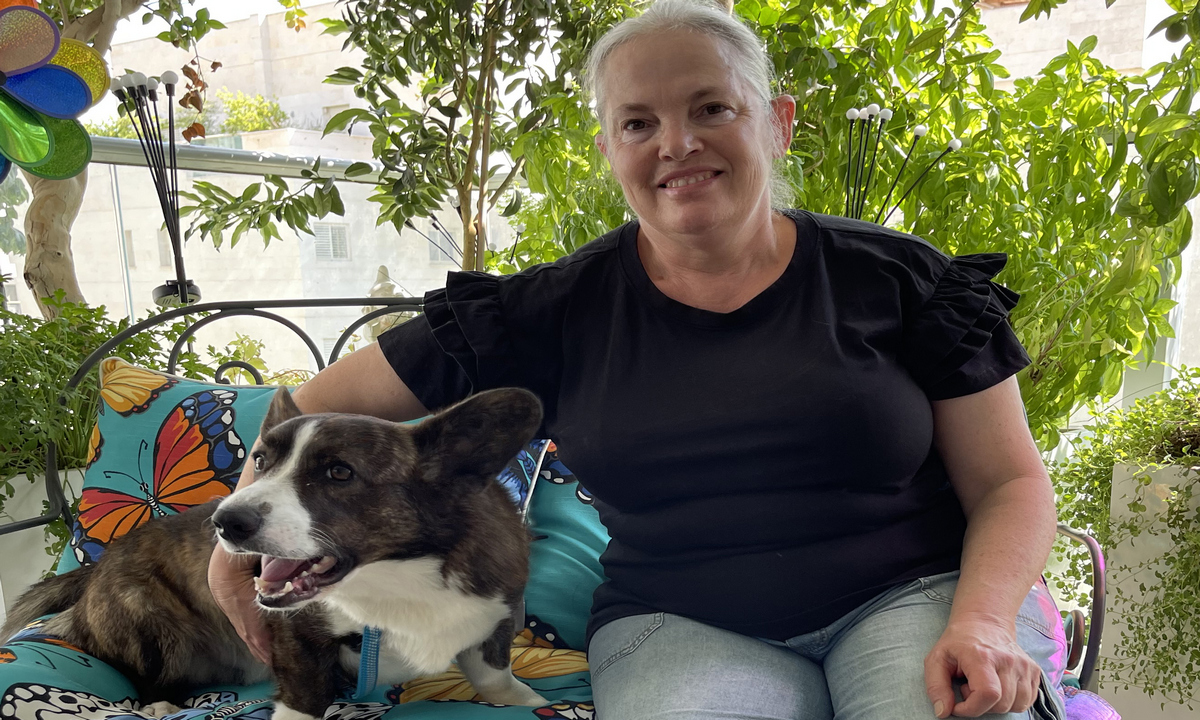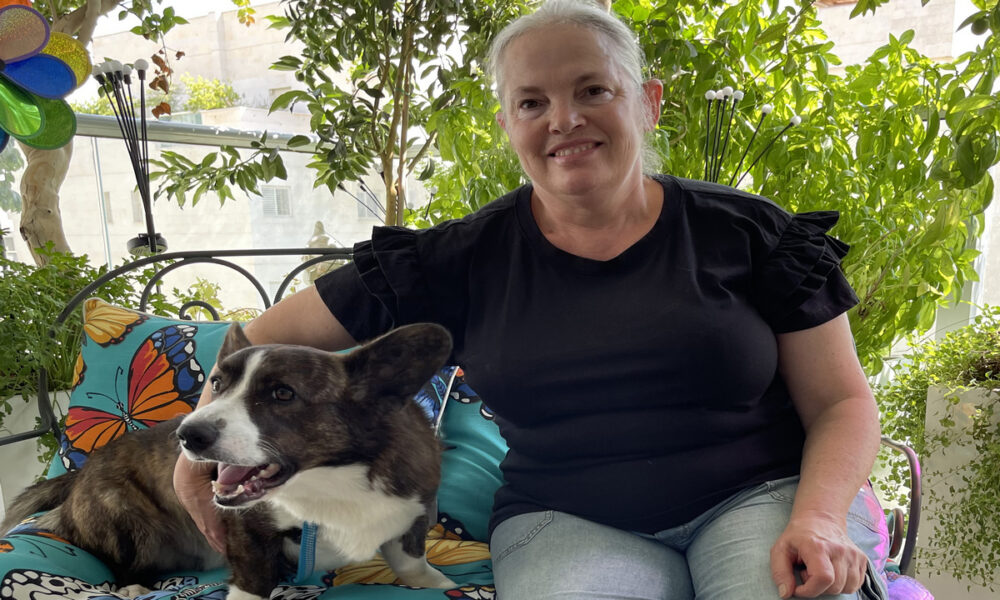october 2023 KPA CTP of the Month

In this quest, Esti read multiple books, completed a one-year course with Kay Laurence, and traveled to conferences within the United States and the United Kingdom. Esti met Karen Pryor at the SPARCS conference in Newport, Rhode Island, in 2014. “Karen sat just behind me, and we chatted. After that meeting, I thought that one day I would take the KPA Dog Trainer Professional (DTP) program.”
As she completed more courses, seminars, and conferences, Esti decided that she should find “a professional course that would put all the bits and pieces of my knowledge in place.” She enrolled in the DTP program out of “curiosity” and to build her own knowledge. “I didn’t intend to be a dog trainer!” Esti completed the DTP World program in April, 201. Her instructor was Terry Ryan and the hands-on part of the program was held in Sequim, Washington.
Before she started the DTP program, Esti felt good about her knowledge. However, “very soon I realized that I was missing a lot of information. For example, I wasn’t aware how important the rate of reinforcement is for successful training sessions.”
For Esti, the most difficult part of the DTP program was finishing the independent, online portion of the course on time so that she could travel to the United States for the in-person part of the program. Esti recalls worrying about completing the practical training with Looli. She shared her concerns with a friend, a breeder of English cocker spaniels. He advised Esti, “If you can’t trust yourself, you can surely trust Looli to complete all of the assignments on time.” Esti reports that her friend was right! “Looli was very smart and learned everything in time.”
Another challenge for Esti was the requirement to train an animal other than a dog. She trained a cat that lived two hours away in “a very small and hectic apartment with six cats, two cocker spaniels, and two teenagers!” Esti reports that it was difficult to keep the young ginger cat focused and engaged with all of the activity around him. She persevered and taught him to spin on cue. To ensure her success, Esti visited a gourmet deli before each training session, buying “everything I could think of that might interest him: salmon paste, liver paste, five kinds of sausages made of different meat, dried fish, dried seafood, and 10 kinds of cat treats. I hope he’ll remember me as Santa for the rest of his life!”
Esti’s journey to her clicker training career actually began when she first realized the conflict between what was a common belief within Israeli society (a dog is JUST a dog) and her own developing, and strong, feelings for and about Looli. “I realized that she is not ‘JUST’ a dog. She is an individual with feelings and cognition, and I want her to have a healthy and fulfilled life.” Esti broke away from the imprinted beliefs she carried regarding the inferiority of dogs, assessing those beliefs as merely excuses to neglect, mistreat, and abuse dogs. Her realization was helped along by reading Patricia McConnell’s For the Love of a Dog. “It gave me the scientific okay to relate to my dog as equal partner.”
These strong beliefs about respecting a dog’s individual physical, mental, and emotional needs and making the dog’s behavior choices central to training have been the foundation of Esti’s work. She strives for clear communication with dogs. “Clear communication with a different species requires knowledge, technical skills, and lots of practice.” Esti ensures that the dogs she works with approach training and learning with great joy. “Happiness and pleasure make life meaningful for dogs and humans.”
In the same way, Esti encourages her clients to aspire to the clearest possible communications with their dogs. “Training should be time spent getting to know each other better and deepening the relationship. It is not just about getting behaviors on cues or the end result.” What training is about, according to Esti, is what the dog and the human learn in the process. “The behavior itself simply provides structure to the training session.”

Training should be time spent getting to know each other better and deepening the relationship. It is not just about getting behaviors on cues or the end result.

When Esti was first introduced to Nose Work with Minnie, her Petit Basset Griffon Vendeen, she became hooked. After learning the basics at Fenzi Dog Sports Academy, she took private online classes with various teachers. In time, Esti began to teach others the sport. Since 2021, she trains and teaches K9 Nose Work exclusively. “In K9 Nose Work, the odor is introduced to the dog organically. This method uses classical conditioning to condition the dog to the odor, using the dog’s innate survival instinct to find food, then pairing food with an odor, and then ultimately removing the food from the behavior. In other Nose Work training, the odor is introduced to the dog with operant conditioning. The dog is first taught the final and desired response to the odor and then that behavior is back-chained to starting the search.” Just recently, Esti earned CNWI (Certified Nose Work Instructor) status!
Esti has found that people and dogs in the United States and Israel all experience the same joys and problems. “I believe that there are good and bad dog people in every nation. Although every time I visit the UK, I get the vibe that it’s a dog-loving nation!”
In her interactions, Esti tries to use positive reinforcement. For example, in talks to groups, she asks a lot of simple questions. “Whoever answers the question always gets a positive response from me, since I want to maintain engagement with my audience.”
Since completing the DTP program, Esti continues to learn. She has earned a Certificate of Excellence for completing the 8-week tele-course Living & Learning with Animals with Susan G. Friedman, Ph. D., completed a Certificate in Applied Animal Behavior from the University of Washington, Professional & Continuing Education, became a Fear Free Certified Professional, completed the Animal Behavior Consulting: Principle & Practice course offered by the IAABC Foundation, completed the Instructor Training Course of the National Association of Canine Scent Work Education Division, attended Dive Deep: An Advanced Training Course with Ken Ramirez at The Ranch, and completed the IAABC Foundation’s The Thinking Animal: Cognition and its Role in Behavior course. Esti says, “What can be learned about dog behavior, cognition, and emotions is endless and the body of knowledge is changing and developing all the time.”
Esti sees dog training as her journey, not just her profession. “Positive training helps me understand the world around me and it helps reveal who I am. Learning about dogs and behavior is a never-ending story for me.”

